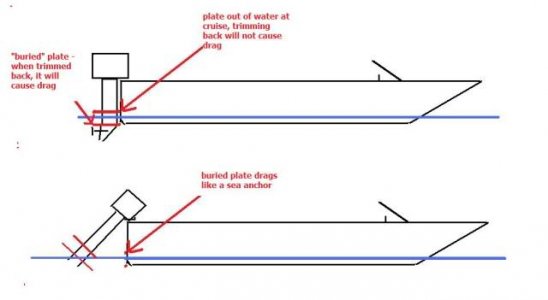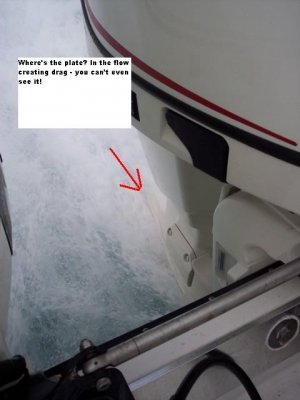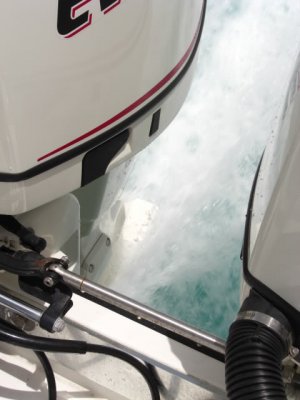I hang out on several other boating and pontoon sites and this comes up almost daily and this is about the best and simplest description of where to start with boat performance issues. I copied and pasted the below info from a verado forum for you to quench your intellectual thirst for knowledge.Thumbs Up
Bill
THIS APPLIES TO EVERY ENGINE AND BOAT AND IS NOT VERADO SPECIFIC
Before you start messing with props, you must get the engine height right. New props are WORTHLESS if they are not given the opportunity to do what they are designed for. And your engine height is probably not at optimum now. It is due to a little known fact about how mfr's rig: they "bury" them a little. Most mfrs rig the engine lower than optimum so they can keep themselves out of liability due to spinouts or blowouts. And raising to optimum won't cause blowouts. Forget all that stuff about using rulers and how far the hull is above/below the prop/plate. It's easy to tell if your engine height is right: with normal load (50% gas) ,get someone to take it up to cruise, trim it normal, and go back and look at the big anti vent plate above the prop on the lower end. It should be OUT of the water at speed, getting splashed is ok, but out of the flow. If it's totally dry in all seas, you're probably too high. If it's "buried" under the water, you need to raise your engine and then start testing props. A buried cavplate is like dragging a bucket on a rope behind your boat: total drag that hurts performance and puts pressure (pull) on the transom. Sorry, not an artist but a really crude pic might help:

An additional advantage in raising is the powerhead 1 -3 inches higher off the water is it reduces the salt/water mist, that gets in the motor and causes corrosion. Courtesy of Ken at propgods.com, here's an E-tec that is "buried":

and here's the same engine mounted at the proper height:

a Verado at proper height:

and how the merc racing team sets the height - a perfect shot of the cav plates getting splashed, but not in the flow. This is not a "racing" setting, this is how everything from a 12 foot to a 42 foot boat should be:

Now back to propping....
Someone writes:
“I don’t think I really need to test my props by going to WOT, I don’t run fast and just like to cruise”
A common misconception is if you are not a full throttle user (WOT), that the props that came with your boat are the proper ones. Running at full throttle is not something that any of us do often, but just like your car transmission selects the right rpm, a good prop does that too. Too big a prop and you will be “lugging” the engine in cruise. But the testing requires WOT (wide open throttle) to see if you are propped correctly for long engine life.
Here is how to tell if you are propped correctly. This may rattle you to cavitate your engines but it'll be OK....
1. Load the boat down with 50% gas and a light load for fishing cruising, etc
2. Find a very flat piece of water a mile long and bring your trim tabs all the way up.
3. Trim your engines "in" and take it up to full WOT and start trimming up
4. Keep trimming up SLOWLY a bit at a time, letting the boat catch up to the setting...until the engine starts cavitating - losing speed ( you can't hurt it - all new engines have rev limiters)
5. Now drop it back down a bit until it "bites"
6. Now look at your rpm...- it should be in the top half of the mfr's recommended top end rpm. For example, the Verado’s range is 5800-6400 rpm. Therefore I should be at least 6100, 6250 would be ideal. But don't get hung up here, anything over 5900 rpm is ok, you won't be hurting the motor. A few more hundred rpm may get you a bit more speed though. But less than 5800 is going to do long term damage to the motors. It will cause the motor to add gas to the oil, raising the oil level and diluting the protection the oil gives the motor. Eventually the crank will fail and it will not be warranty.
7. Fill out the PDF sheet below so you can compare after you are completed.
compare the results on a prop slip calculator - at WOT and cruise you should be less than 10%---> go here: http://www.rbbi.com/folders/prop/propcalc.htm
It should be noted that prop changing is not a magic cure-all - all you can do is try to get your props up near the upper range of mfr WOT and that's about it. Too many people think changing props is like adding Nitrous or 50 more HP...not so....it's fine tuning in my opin, and for me never been worth more than a few mph or gph when changing a pitch up or down...However, many props are different.... some are smoother than others..others allow you to dock better ....it's not just all about hard statistics....I personally run a prop that gets a bit worse mpg and less top end but it "feels" better than all the others I tried....Don't get hung up on specs searching for the "holy prop grail".
Size depends on what you find above, but three of the best props for < 35 feet are Merc’s Tempest Plus, the Revolution 4 (4 blade) and the new Enertia. Most boats come with a Mirage plus as it is a good all purpose prop.
Discuss your results with our prop expert here - Ken Reeves of Propgods.com. See his site.
Bill
THIS APPLIES TO EVERY ENGINE AND BOAT AND IS NOT VERADO SPECIFIC
Before you start messing with props, you must get the engine height right. New props are WORTHLESS if they are not given the opportunity to do what they are designed for. And your engine height is probably not at optimum now. It is due to a little known fact about how mfr's rig: they "bury" them a little. Most mfrs rig the engine lower than optimum so they can keep themselves out of liability due to spinouts or blowouts. And raising to optimum won't cause blowouts. Forget all that stuff about using rulers and how far the hull is above/below the prop/plate. It's easy to tell if your engine height is right: with normal load (50% gas) ,get someone to take it up to cruise, trim it normal, and go back and look at the big anti vent plate above the prop on the lower end. It should be OUT of the water at speed, getting splashed is ok, but out of the flow. If it's totally dry in all seas, you're probably too high. If it's "buried" under the water, you need to raise your engine and then start testing props. A buried cavplate is like dragging a bucket on a rope behind your boat: total drag that hurts performance and puts pressure (pull) on the transom. Sorry, not an artist but a really crude pic might help:

An additional advantage in raising is the powerhead 1 -3 inches higher off the water is it reduces the salt/water mist, that gets in the motor and causes corrosion. Courtesy of Ken at propgods.com, here's an E-tec that is "buried":

and here's the same engine mounted at the proper height:

a Verado at proper height:

and how the merc racing team sets the height - a perfect shot of the cav plates getting splashed, but not in the flow. This is not a "racing" setting, this is how everything from a 12 foot to a 42 foot boat should be:

Now back to propping....
Someone writes:
“I don’t think I really need to test my props by going to WOT, I don’t run fast and just like to cruise”
A common misconception is if you are not a full throttle user (WOT), that the props that came with your boat are the proper ones. Running at full throttle is not something that any of us do often, but just like your car transmission selects the right rpm, a good prop does that too. Too big a prop and you will be “lugging” the engine in cruise. But the testing requires WOT (wide open throttle) to see if you are propped correctly for long engine life.
Here is how to tell if you are propped correctly. This may rattle you to cavitate your engines but it'll be OK....
1. Load the boat down with 50% gas and a light load for fishing cruising, etc
2. Find a very flat piece of water a mile long and bring your trim tabs all the way up.
3. Trim your engines "in" and take it up to full WOT and start trimming up
4. Keep trimming up SLOWLY a bit at a time, letting the boat catch up to the setting...until the engine starts cavitating - losing speed ( you can't hurt it - all new engines have rev limiters)
5. Now drop it back down a bit until it "bites"
6. Now look at your rpm...- it should be in the top half of the mfr's recommended top end rpm. For example, the Verado’s range is 5800-6400 rpm. Therefore I should be at least 6100, 6250 would be ideal. But don't get hung up here, anything over 5900 rpm is ok, you won't be hurting the motor. A few more hundred rpm may get you a bit more speed though. But less than 5800 is going to do long term damage to the motors. It will cause the motor to add gas to the oil, raising the oil level and diluting the protection the oil gives the motor. Eventually the crank will fail and it will not be warranty.
7. Fill out the PDF sheet below so you can compare after you are completed.
compare the results on a prop slip calculator - at WOT and cruise you should be less than 10%---> go here: http://www.rbbi.com/folders/prop/propcalc.htm
It should be noted that prop changing is not a magic cure-all - all you can do is try to get your props up near the upper range of mfr WOT and that's about it. Too many people think changing props is like adding Nitrous or 50 more HP...not so....it's fine tuning in my opin, and for me never been worth more than a few mph or gph when changing a pitch up or down...However, many props are different.... some are smoother than others..others allow you to dock better ....it's not just all about hard statistics....I personally run a prop that gets a bit worse mpg and less top end but it "feels" better than all the others I tried....Don't get hung up on specs searching for the "holy prop grail".
Size depends on what you find above, but three of the best props for < 35 feet are Merc’s Tempest Plus, the Revolution 4 (4 blade) and the new Enertia. Most boats come with a Mirage plus as it is a good all purpose prop.
Discuss your results with our prop expert here - Ken Reeves of Propgods.com. See his site.
Attachments



Last edited:
